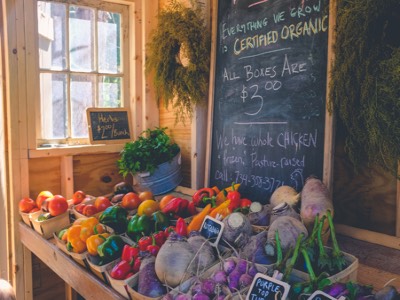
COVID-19 and Local Foods
In today’s blog, I will cover in more detail the impacts of COVID-19 on consumers and local food systems.
While consumer spending in general is down nationwide (-20.5% through April 30, 2020) and in Utah (-17.5%), consumer spending on groceries is up 20% nationwide and 27.3% in Utah (Source). The increased consumer spending on food is a result of eating additional meals at home due to stay-at-home orders and school closures. We are no longer eating at school or work, nor meeting colleagues and customers for lunch or celebrating family events with special restaurant dinners. Many restaurants remain closed or are only providing limited curbside pick up meal services. Additionally, food shortages have led to increased grocery store pricing, early estimates show that food prices nationwide increased by 2.6% between March and April of this year (Source).
Importantly, a portion of the growth in consumer grocery spending is attributable to increased purchases of local foods, organics, and other specialty foods. Why are consumers turning to local foods? Consumers see half empty grocery store shelves and media attention focused on meat processor shutdowns, employee strikes at warehouse and distribution centers, and they start to wonder where their next meal is coming from. Consumers are also concerned about food safety and the potential spread of COVID-19 through food chain interactions. Whether these concerns are warranted or not, isn’t really the issue. Consumers are now focusing on where their food comes from and the number of stops it makes from farm to fork (Growing An Appreciation for the Hands That Feed Us, The Sickness in Our Food Supply).
COVID-19 has increased our awareness of the vital role that local food systems play in reducing food insecurity and providing food sovereignty to residents, when national food supply chains break down or are impeded (In the Face of COVID-19, State Legislators Push for Federal Support of Local Food Systems). Consumers are turning to local food systems to alleviate both their food availability and security concerns. Recent media has highlighted increased consumer demand for local foods, specifically through high enrollment in Community Supported Agriculture (CSA) programs, increased membership and spending at community food coops and online direct from farmers and farmer groups (Community Food Coops Are Thriving During the Pandemic, As Food Supply Chain Breaks Down, Farm-to-Door CSAs Take Off). Americans have also turned to home gardening in mass, leading to long lines at garden centers. Families are spending time gardening, not only to grow food, but to provide diversion, as sports, recreation, and shopping activities are out (The Rebirth of Urban Ag is a Coronavirus Silver Lining).
The uptake in consumer interest in local food is especially apparent for poultry, beef, and lamb (As COVID-19 Disrupts the Industrial Meat System: Independent Processors Have a Moment to Shine). At the same time, backlogs in traditional poultry and meat processing facilities due to closures, creates additional supply of animals from local ranchers. In Utah, the Department of Agriculture and Food has started inspecting private and custom meat plants so that their products can be sold in grocery and other retail outlets (Details). Ranchers are reporting their online meat sales have jumped as much as five-fold and CSA programs sold out of their egg and meat shares early (Going Local: The Case for Bringing America’s Meat Supply Closer to Home).
Consumers are also buying more locally to purchase larger quantities or in bulk, have items delivered, and generally limit their trips to the grocery store. However, the prevalence of fresh produce and meats in the home requires cooking, storage, canning, etc. Michael Pollen recently said the lockdown has created a “renaissance of home cooking and baking.” Consumers are creatively coming up with ideas on how to use 50 pounds of flour or potatoes, 10 pounds of coffee, and 24 cans of beans (What to do with 50 Pounds of Potatoes? The Quandaries of Bulk Buying). Some of the bulk buying is due to minimum order requirements set by local cooperatives and online stores, often around a $100.
For our local farmers and ranchers there is lots of opportunity to provide for consumers seeking local foods. They also need your assistance in learning more about cooking, canning, gardening, etc. Providing customers with seeds, starts, recipies, and storage ideas, or posting videos, such as cooking demonstrations, wine/beer pairings, home gardening how-to’s and such to your website or social media pages will greatly enhance their post purchase experience and keep them coming back to you as a trusted resource.
I have been asked several times if the new trend favoring local foods will continue to grow or stay strong. My feeling at this time is that many consumers who had not participated in a CSA or purchased beef from a local rancher prior to the pandemic, will continue to do so afterward as they discover the value of the buy local experience (freshness, taste, community, etc.). Will some go back to their old habits? Yes, some will, but certainly not all. A recent presentation I made on COVID-19 impacts to local foods can be found here.
That’s all for now. If you have a topic you would like to see covered in a future blog, feel free to contact me.
Stay healthy!
Kynda Curtis, USU Extension Ag and Food Marketing Specialist
kynda.curtis@usu.edu
Online workshops, courses, webinars, and podcasts:
- University Center for Economic Development, University of Nevada, Reno, Webinar. Sage Outlook: COVID-19 Impacts on Local Food Systems with Dr. Kynda Curtis: https://www.youtube.com/watch?v=P_pgpXe7GIs&feature=youtu.be
- New Regulations for Utah Farmers Markets & What They Mean to Operators and Direct Marketing Farmers Webinar: https://www.youtube.com/watch?v=mf5PNptlqKU
Resources:
- USU Extension COVID-19 Resources: https://extension.usu.edu/covid-19/
- Marketing in Motion Blog Posts: https://extension.usu.edu/apec/news/
- UDAF Utah’s Own Program: https://www.utahsown.org
- UDAF COVID-19 Resources: https://ag.utah.gov/covid-19-news-and-updates/
- Taxes and Federal Programs: https://ruraltax.org
Disclaimer: This blog is for information purposes only. USU Extension does not endorse any specific product or service that may be mentioned here in.

